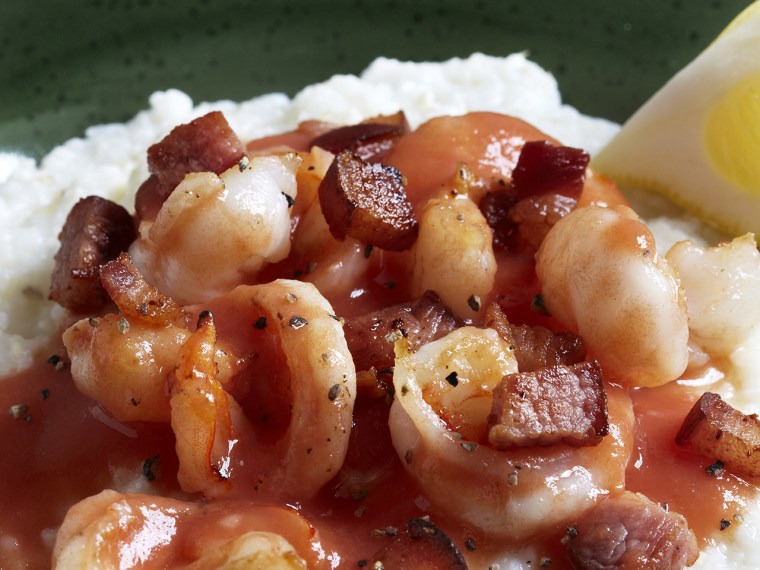Matt Lee and Ted Lee are natives of Charleston, S.C., a place that gave the brothers a deep and abiding love of delicious “Lowcountry” cuisine. Here, the food and travel writers share a recipe for shrimp and grits from their newest cookbook, “The Lee Bros. Charleston Kitchen.”
“These days everyone’s got his or her own riff on shrimp and grits, and our own formula seems always to be evolving,” they write in the cookbook. “This recipe represents our latest take on the dish ...

“Each shrimp piece is easier to eat in one bite, the twisted shape grabs more sauce and gives the overall impression of a lighter dish. Especially if jumbo shrimp are the only ones available in your area, you’ll find this an appealing way to cook shrimp and grits.”
Recipes reprinted from the book "The Lee Bros. Charleston Kitchen" by Matt Lee and Ted Lee. Copyright © 2013 by Matt Lee and Ted Lee. Photographs copyright © 2013 by Squire Fox. Published by Clarkson Potter, a division of Random House, Inc.
Shrimp and grits"The Lee Bros. Charleston Kitchen" by Matt Lee and Ted Lee
Serves: 4. Time: 1 hour.
To prepare the shrimp:
1. Peel and de-vein the shrimp, reserving the shrimp in a bowl and the shells in a small saucepan. Add 2 cups of water, the bay leaf, 1/2 teaspoon kosher salt, 1/4 teaspoon of the sugar, and the cayenne to the saucepan with the shells. With a spoon, tamp the shells down beneath the surface of the water, cover, and bring to a simmer over high heat. Uncover, turn the heat to medium low, and let the shrimp stock simmer until reduced by half, about 10 minutes.
2. Meanwhile, with a sharp knife, slice the shrimp in half lengthwise.
3. Put the tomatoes in a blender or food processor and add the vinegar, 1/2 teaspoon salt, and the remaining 1/2 teaspoon sugar. Process to a smooth purée, then strain through a fine sieve, pressing the skin and seeds to extract as much juice as possible. Discard the skin and seeds. You should have 1 1/2 cups of tomato purée.
4. Scatter the bacon in a large sauté pan over medium-high heat and cook, stirring occasionally, until the bacon is alluringly browned and has rendered its fat, about 8 minutes. Using a slotted spoon, transfer the bacon to a small paper-towel-lined plate and cook the shrimp in the bacon fat in batches, taking care not to crowd the pan, and stirring occasionally, just until they’ve curled into corkscrews and turned pink, about 2 minutes; reserve on a plate. Squeeze half the lemon over the shrimp and sprinkle with 2 pinches of salt.
5. Strain the shrimp stock into the sauté pan, discarding the solids, and stir with a wooden spoon to pick up the tasty browned bits from the bottom of the pan. When the stock simmers, spoon off 2 tablespoons and then whisk them into the flour with a fork in a small bowl to make a paste. Add the tomato purée and the garlic to the pan, stir to combine, and then whisk the flour paste into the sauce. Cook until the mixture thickly coats the back of a spoon.
6. Cut the heat, and fold the shrimp in just to warm through. Season to taste with salt, black pepper, and red wine vinegar. Cut the remaining lemon half into 4 wedges. Serve the shrimp over hot Charleston Hominy, and garnish with the reserved bacon and the lemon wedges.
To make the Charleston Hominy:
1. Pour the milk and 2 cups of water into a 2-quart saucepan, cover, and turn the heat to medium high. When the liquid simmers, add the grits, butter, and 1/2 teaspoon salt, and reduce the heat to medium. Stir every couple of minutes until the grits have become fragrant, and are the consistency of thick soup, about 8 minutes.
2. Reduce the heat to low and simmer, stirring often and ever more frequently, for about 20 minutes, by which time the bubbles will emerge infrequently as the grits have stiffened and fall lazily from the end of a spoon. Add 1/2 teaspoon black pepper and cook for about 10 minutes more, stirring constantly to prevent the thickened grits from scorching on the bottom of the pan (appoint someone to the stirring task if you have to step away — a scorched pot of grits is bitter and a total loss). If your grits thicken too quickly, or if they are too gritty for your taste, add water by the half cup, stirring to incorporate, and continue cooking until tender.
3. When the grits are stiff and stick well to the spoon, turn off the heat and stir. Season with salt and black pepper to taste and serve immediately. Makes 3 cups.
517249646048102693560499headless large (21 to 25 count) shell-on shrimp1.25pound1 1/4 pounds headless large (21 to 25 count) shell-on shrimpbay leaf11 bay leafKosher saltsugar0.75teaspoon3/4 teaspoon sugarcayenne1pinch1 pinch of cayennevine-ripened tomatoes, cored and quartered1pound1 pound vine-ripened tomatoes, cored and quarteredred wine vinegar, plus more to taste1teaspoon1 teaspoon red wine vinegar, plus more to tasteslab bacon, cut into large dice4ounce4 ounces slab bacon, cut into large dicelemon, halved11 lemon, halvedall-purpose flour1tablespoon1 tablespoon all-purpose flourgarlic cloves, minced22 garlic cloves, mincedFreshly ground black pepperCharleston Hominy (recipe follows)whole milk2cup2 cups whole milkstone-ground coarse grits1cup1 cup stone-ground coarse gritsunsalted butter2tablespoon2 tablespoons unsalted butterKosher salt and freshly ground black pepper